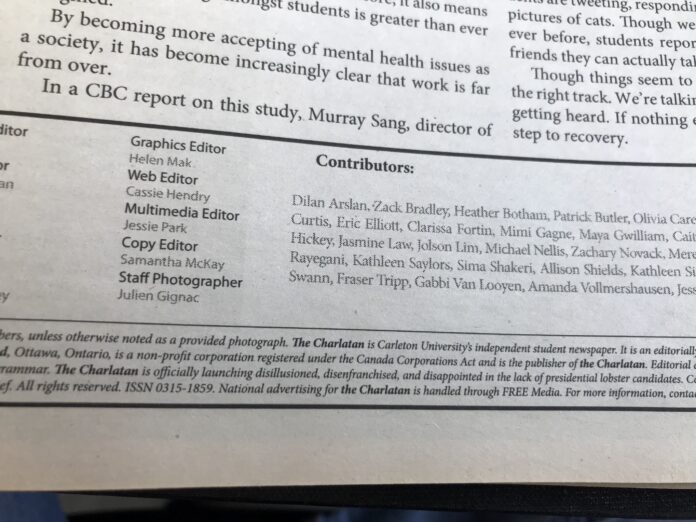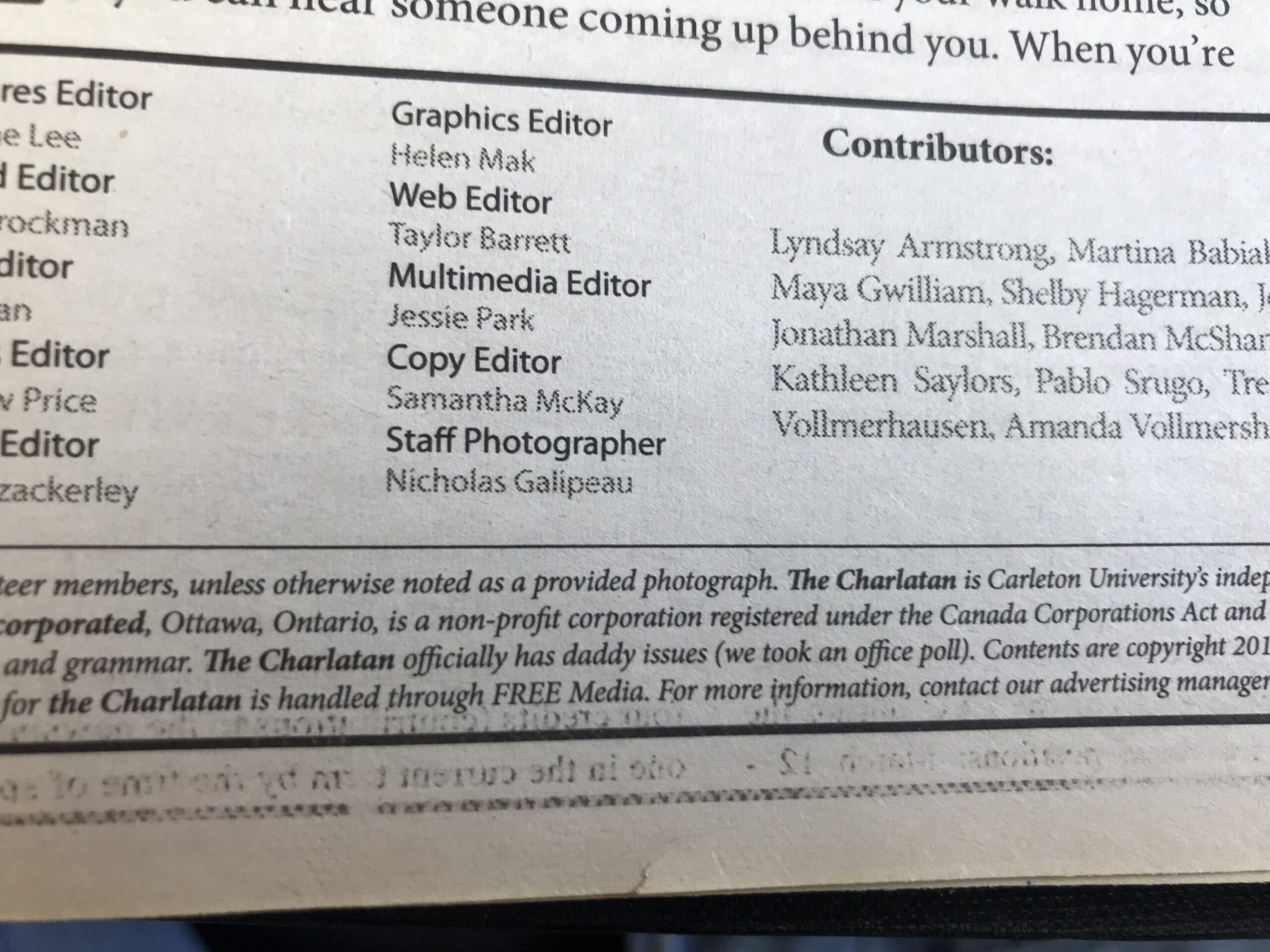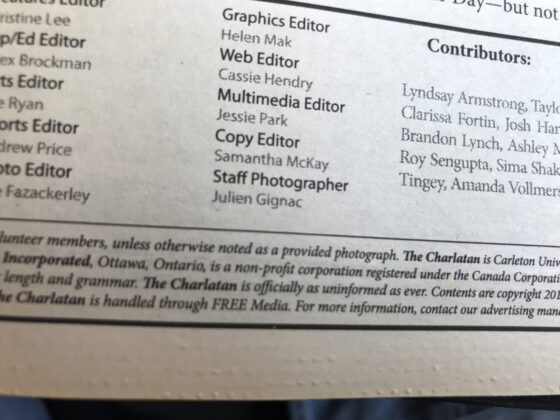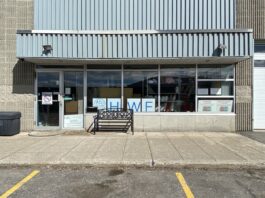Carleton University’s independent student newspaper, the Charlatan, marks its 77th birthday this year. The Charlatan’s print edition, now reduced from weekly publication to once per semester, still contains the editors’ jokes as it did when the paper began.
The oldest news publication on campus, the paper was first published as the Carleton on Nov. 28, 1945. The paper has been a haven for new journalists with a penchant for pranks and “rocking the boat,” according to past staff. From protests for free press that had the RCMP called to non-binary mannequins, the paper has maintained its reputation for chaos. This is the story of that chaos.
Misnomers and mischief
“We would send bricks through interoffice mail to the dean of administration,” Phil Kinsman, editor-in-chief in the 1970-71 publication year, said over the phone.
His voice crackled over the airwaves as he described an early act of protest by Charlatan contributors. Carleton’s University Centre had just been built as an attachment to the older cafeteria, but students wanted the new masonry to continue around the building’s entire perimeter. While the students’ efforts were unsuccessful, Kinsman said they were indicative of the paper’s spirit.
Kinsman characterized the early years of the Charlatan—then, the Carleton—as an environment of activism. Stories of the paper’s early history tell tales of acts against censorship and even bicycle ride-ins, where students brought their bikes to the office of the student services dean to ask for more bicycle stands on campus.
“[It was] all very jovial,” Kinsman said. “There was nothing angry about it—that kind of stuff went on all the time. There was a men’s bake sale for women’s liberation where men made cakes and muffins and stuff and raised money for the women’s liberation group on campus.”
Acts of protest led to criticism. The RCMP was called once when an annotated version of the Front de Libération du Québec (FLQ)’s manifesto was published in the newspaper. Heated debates over objectivity and freedom of the press ensued.
In 1971, after years of conversation, the paper changed its name in yet another act of protest. The Charlatan was born as a counter to “true objectivity,” Kinsman said.
CUSA connections
The paper’s “fight the power” attitude continued until 1988, when editorial staff separated from the Carleton University Students’ Association (CUSA).
CUSA had until that point been the Charlatan’s publisher and landlord, according to Evan Annett, features editor in 2005. Annett is also the author of “You Charlatans,” a short history of the newspaper written in Annett’s last year with the paper.
Annett’s history details councillors’ disillusionment with the Charlatan’s focus on “merry japes and not enough on CUSA or its positive achievements” dating back to 1974. As tensions between CUSA and the paper grew during the next decade and a half, editors became increasingly worried about CUSA’s involvement in the paper’s editorial content.
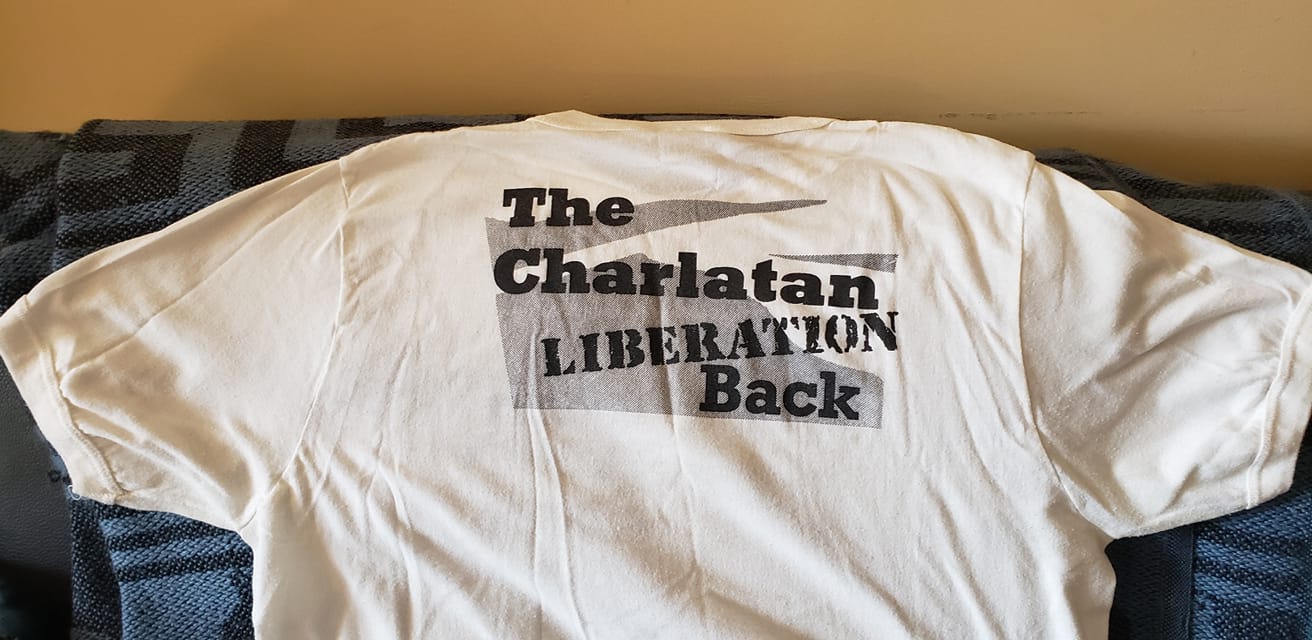

Greg Ip, editor-in-chief from 1987-88, led the final push, and Derek Raymaker, editor-in-chief from 1988-89 was there to watch it happen.
“A bunch of editors had made plays for autonomy from CUSA before I even got to Carleton, and for the most part, they were kind of laughed out,” Raymaker said. “CUSA was basically saying, ‘There’s no way we’re letting you make your own financial decisions’… The subtext of what they were saying [was], ‘Because we control your budget, we can have a lot of leverage in how you report the news about us.’”
CUSA and the Charlatan settled on a vote. Editors and volunteers for the paper spent hours campaigning and heckling students, according to Ip’s final report on his term as editor-in-chief.
“Vote yes for a free press or I’ll hang your puppies,” was one of several humorous slogans Ip noted in his report that he had called out to students in the hallways.
While only about nine per cent of the student body turned up to vote, the Charlatan won its independence. The creative—and somewhat threatening—campaign strategy worked.
Masthead misbehaviour
After a few years, antics at the paper hit a lull as independence from CUSA meant editors needed to take their work slightly more seriously to maintain the paper’s reputation and advertising support.
David Ebner, editor-in-chief from 1997-98, described the environment as “stuffy” and said he and his team worked hard to inject more fun into their daily work.
“Our goal was to 1 million per cent keep up the standards of news reporting,” Ebner said. “But also, we’re 20 years old, right? So we tried to make it more fun.”
His roommate, Grant Ellis, suggested the paper begin a call-in voice mail system known as the “voicebox” for complaints and rants, which students called in to for several years.
Ebner’s team introduced comics to the paper as well, but the longest standing tradition they introduced is the secret note in the print masthead.
Each week on Wednesdays, the night before the paper went to print, all editors would cram into the Charlatan office and work on the print layout. A Red Bull-fueled frenzy, according to Rachel Collier, editor-in-chief for the 2013-14 production year, production nights saw most of the Charlatan’s hijinks and bonding.
“It was like the first place that I really belonged, like a ragtag team of misfits,” Collier said.
Ebner said he and his “ragtag” team would bribe the printer’s delivery person with pop and cold pizza to buy extra time for layout into the wee hours of the morning. The chaos and overtiredness lent itself to numerous inside jokes, which editors began printing in the masthead in 1997.
Masthead notes have included “The Charlatan is officially not getting enough out of their avocadoes,” “The Charlatan’s official grandparents are yours ‘til they’re done Cumming,” “The Charlatan is officially more of a nap haven with magical dancing happenstances than a newspaper,” and “The Charlatan is officially looking for a touring drummer to join our Wii rock band (serious offers only).”
Office objects
The paper’s masthead points to more secrets than the joke of the week for Charlatan editors. It also hides the beginnings of years-long staff traditions. One of the most notable standing traditions in recent history is the inclusion of Stephen, a gold-coloured mannequin, nearly six feet tall with no arms, in editorial meetings and decisions.
The hidden note in the masthead that week read, “The Charlatan officially welcomes Stephen with open arms.”
Stephen was adopted into the ‘charla-family’ on Oct. 15, 2014. That night, production manager Jon Willemsen rescued Stephen from a pile of garbage on the fifth floor of Carleton’s University Centre and lugged through the hall to a bustling Charlatan office on production night.

Willemsen named Stephen with the other editors. He said the editors were careful to treat Stephen like one of their own from the beginning.
“We don’t use [gendered] pronouns for Stephen, because we don’t know if they’re a ‘he’ or ‘she,’” Willemsen said while recounting how the staff tried to accommodate Stephen’s wishes, even though they couldn’t speak.
He added that every effort was made to make Stephen feel comfortable. He recounted bringing Stephen into the office, dressing them in Mardi Gras beads, a graduation cap and a Charlatan T-shirt. Weeks later, Willemsen watched other editors fill in Stephen’s eyebrows.

“It’s funny just because it was such an innocent thing. I just remember bringing them into the office one day and just thinking it was mostly just a joke,” Willemsen said.
As with most jokes at the Charlatan, Stephen became a permanent fixture.
“You know how things work in the Charlatan office. Once you bring something in, it never leaves,” Willemsen said. “The fact that Stephen was in the office for eight years is borderline shocking, but also completely expected.”
Stephen was accidentally thrown out in September 2021 alongside a pile of garbage collected during an office cleanout, according to then-editor-in-chief Jillian Piper. Many members of the current editorial staff are unsure that “accidental” is the correct word to use.
Preserving the pranks
While past editors have moved on and remnants of the paper’s history exist only in memories and archived volumes, current editors are striving to preserve the Charlatan’s jovial spirit.
Now, visitors to 531 University Centre can expect to find a hockey stick hanging from the ceiling tiles, a 20-year-old fridge consumed by yellow stickers, turtle porn and a plastic Nerf gun editors use to shoot each other when they are feeling particularly rambunctious.
For many editors, the jokes and people at the paper were what made the Charlatan worthwhile. Raymaker is one of those editors, and he says he and many of his co-workers are still in touch.
“I wasn’t super excited about going to Carleton or being a student or anything like that,” Raymaker said. “The charlatans gave me a close connection to the campus and got me interested in a lot of other things that were going on … rocking the boat and doing my bit to make Carleton a better place to study and hang out, grow up and become a real person.”
In a previous version of this article, Greg Ip was misnamed “David Ip.” The Charlatan regrets the error.
Featured image by Isabel Harder.

